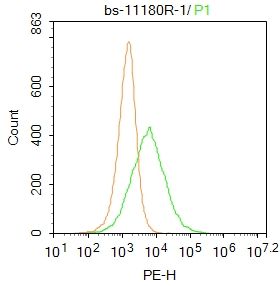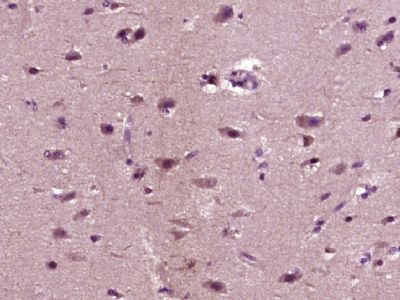ABCA7 Polyclonal Antibody
Purified Rabbit Polyclonal Antibody (Pab)
- 产品详情
- 实验流程
Application
| IHC-P, IHC-F, IF, ICC, E |
|---|---|
| Primary Accession | Q8IZY2 |
| Reactivity | Rat |
| Host | Rabbit |
| Clonality | Polyclonal |
| Calculated MW | 234350 Da |
| Physical State | Liquid |
| Immunogen | KLH conjugated synthetic peptide derived from human ABCA7 |
| Epitope Specificity | 251-350/2146 |
| Isotype | IgG |
| Purity | affinity purified by Protein A |
| Buffer | 0.01M TBS (pH7.4) with 1% BSA, 0.02% Proclin300 and 50% Glycerol. |
| SUBCELLULAR LOCATION | Cell membrane; Multi-pass membrane protein. Golgi apparatus membrane; Multi-pass membrane protein. Endosome membrane; Multi-pass membrane protein. Note=Localizes to cell membrane ruffles and phagocytic cups of macrophages stimulated with C1q or apoptotic cells. Localizes to the cytoplasm of resting macrophages, probably in Golgi and endosomes. Localizes to the apical brush border of cells in the proximal tubules of kidney. Isoform 2 may localize to the endoplasmic reticulum. |
| SIMILARITY | Belongs to the ABC transporter superfamily. ABCA family. Contains 2 ABC transporter domains. |
| Important Note | This product as supplied is intended for research use only, not for use in human, therapeutic or diagnostic applications. |
| Background Descriptions | ATP-binding cassette (ABC) transporters are an evolutionarily conserved family of widely-expressed proteins that use ATP hydrolysis to catalyze the transport of various molecules across extracellular and intracellular membranes. Eukaryotic ABC transporters are largely responsible for trafficking hydrophobic compounds either within the cell as part of a metabolic process, outside the cell for transport to other organs, or for secretion from the body. The cholesterol-responsive transporter, ABCA7, maps to human chromosome 19 and mouse chromosome 10 and has been reported as a candidate regulator of ceramide transport in epidermal lipid reorganization. High expression levels of ABCA7 have been reported in myelolymphatic tissues, reticuloendothelial cells, peripheral leukocytes, thymus, spleen and bone marrow. This expression pattern of the two alternatively-spliced isoforms also indicates an involvement in lipid homeostasis in cells of the immune system, though the complete role of ABCA7 is not yet known. Full-length type I ABCA7 has shown plasma membrane localization, while the type II splicing variant has shown expression predominantly in the endoplasmic reticulum. |
| Gene ID | 10347 |
|---|---|
| Other Names | Phospholipid-transporting ATPase ABCA7, 7.6.2.1, ABCA-SSN, ATP-binding cassette sub-family A member 7, Autoantigen SS-N {ECO:0000303|Ref.6}, Macrophage ABC transporter, ABCA7 (HGNC:37) |
| Target/Specificity | Expressed in leukocytes (at protein level). Widely expressed. Highly expressed in myelo-lymphatic tissues including peripheral leukocytes, thymus, spleen and bone marrow. Isoform 2 is more abundant in lymph node, spleen, thymus and trachea than isoform 1 which is more strongly expressed in brain and bone marrow. |
| Dilution | IHC-P=1:100-500,IHC-F=1:100-500,ICC=1:100-500,IF=1:100-500,Flow-Cyt=1ug/test,ELISA=1:5000-10000 |
| Format | 0.01M TBS(pH7.4) with 1% BSA, 0.09% (W/V) sodium azide and 50% Glyce |
| Storage | Store at -20 °C for one year. Avoid repeated freeze/thaw cycles. When reconstituted in sterile pH 7.4 0.01M PBS or diluent of antibody the antibody is stable for at least two weeks at 2-4 °C. |
| Name | ABCA7 (HGNC:37) |
|---|---|
| Function | Catalyzes the translocation of specific phospholipids from the cytoplasmic to the extracellular/lumenal leaflet of membrane coupled to the hydrolysis of ATP (PubMed:24097981). Transports preferentially phosphatidylserine over phosphatidylcholine (PubMed:24097981). Plays a role in lipid homeostasis and macrophage- mediated phagocytosis (PubMed:12917409, PubMed:12925201, PubMed:14570867, PubMed:14592415). Binds APOA1 and may function in apolipoprotein-mediated phospholipid efflux from cells (PubMed:12917409, PubMed:14570867, PubMed:14592415). May also mediate cholesterol efflux (PubMed:14570867). May regulate cellular ceramide homeostasis during keratinocyte differentiation (PubMed:12925201). Involved in lipid raft organization and CD1D localization on thymocytes and antigen-presenting cells, which plays an important role in natural killer T-cell development and activation (By similarity). Plays a role in phagocytosis of apoptotic cells by macrophages (By similarity). Macrophage phagocytosis is stimulated by APOA1 or APOA2, probably by stabilization of ABCA7 (By similarity). Also involved in phagocytic clearance of amyloid-beta by microglia cells and macrophages (By similarity). Further limits amyloid-beta production by playing a role in the regulation of amyloid-beta A4 precursor protein (APP) endocytosis and/or processing (PubMed:26260791). Amyloid-beta is the main component of amyloid plaques found in the brains of Alzheimer patients (PubMed:26260791). |
| Cellular Location | Cell membrane; Multi-pass membrane protein. Golgi apparatus membrane {ECO:0000250|UniProtKB:Q91V24}; Multi-pass membrane protein. Early endosome membrane {ECO:0000250|UniProtKB:Q91V24}; Multi-pass membrane protein. Cytoplasm {ECO:0000250|UniProtKB:Q91V24}. Cell projection, ruffle membrane {ECO:0000250|UniProtKB:Q91V24}. Cell projection, phagocytic cup {ECO:0000250|UniProtKB:Q91V24} Note=Localizes to cell membrane ruffles and phagocytic cups of macrophages stimulated with C1q or apoptotic cells. Localizes to the cytoplasm of resting macrophages, probably in Golgi and endosomes Localizes to the apical brush border of cells in the proximal tubules of kidney (By similarity). {ECO:0000250|UniProtKB:Q91V24} |
| Tissue Location | Expressed in leukocytes (at protein level) (PubMed:10873640). Widely expressed (PubMed:10873640). Highly expressed in myelo-lymphatic tissues including peripheral leukocytes, thymus, spleen and bone marrow (PubMed:10873640, PubMed:11435699). Expressed in the hippocampus and the cerebellum (PubMed:27472885). Isoform 2: Abundant in lymph node, spleen, thymus and trachea (PubMed:14592415) Isoform 1: Strongly expressed in brain and bone marrow (PubMed:14592415). |
Research Areas
For Research Use Only. Not For Use In Diagnostic Procedures.
Application Protocols
Provided below are standard protocols that you may find useful for product applications.
终于等到您。ABCEPTA(百远生物)抗体产品。
点击下方“我要评价 ”按钮提交您的反馈信息,您的反馈和评价是我们最宝贵的财富之一,
我们将在1-3个工作日内处理您的反馈信息。
如有疑问,联系:0512-88856768 tech-china@abcepta.com.
¥ 1,500.00
Cat# AP54416























 癌症的基本特征包括细胞增殖、血管生成、迁移、凋亡逃避机制和细胞永生等。找到癌症发生过程中这些通路的关键标记物和对应的抗体用于检测至关重要。
癌症的基本特征包括细胞增殖、血管生成、迁移、凋亡逃避机制和细胞永生等。找到癌症发生过程中这些通路的关键标记物和对应的抗体用于检测至关重要。 为您推荐一个泛素化位点预测神器——泛素化分析工具,可以为您的蛋白的泛素化位点作出预测和评分。
为您推荐一个泛素化位点预测神器——泛素化分析工具,可以为您的蛋白的泛素化位点作出预测和评分。 细胞自噬受体图形绘图工具为你的蛋白的细胞受体结合位点作出预测和评分,识别结合到自噬通路中的蛋白是非常重要的,便于让我们理解自噬在正常生理、病理过程中的作用,如发育、细胞分化、神经退化性疾病、压力条件下、感染和癌症。
细胞自噬受体图形绘图工具为你的蛋白的细胞受体结合位点作出预测和评分,识别结合到自噬通路中的蛋白是非常重要的,便于让我们理解自噬在正常生理、病理过程中的作用,如发育、细胞分化、神经退化性疾病、压力条件下、感染和癌症。







